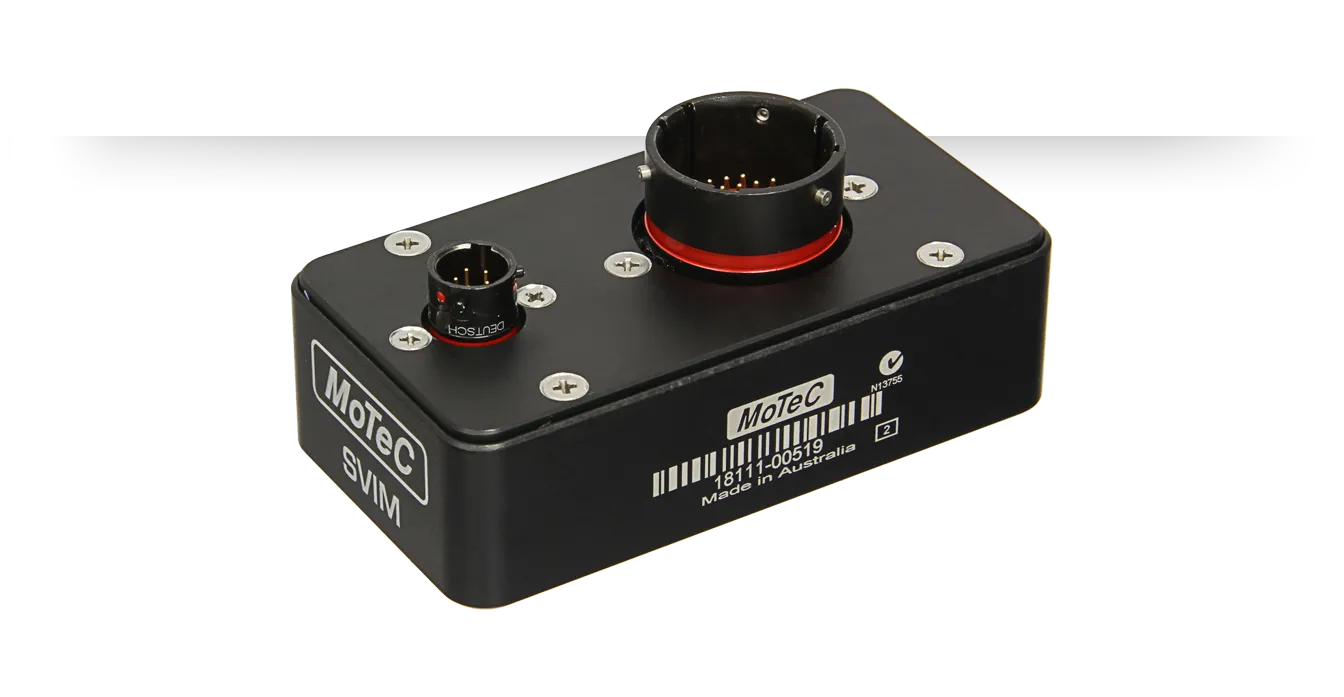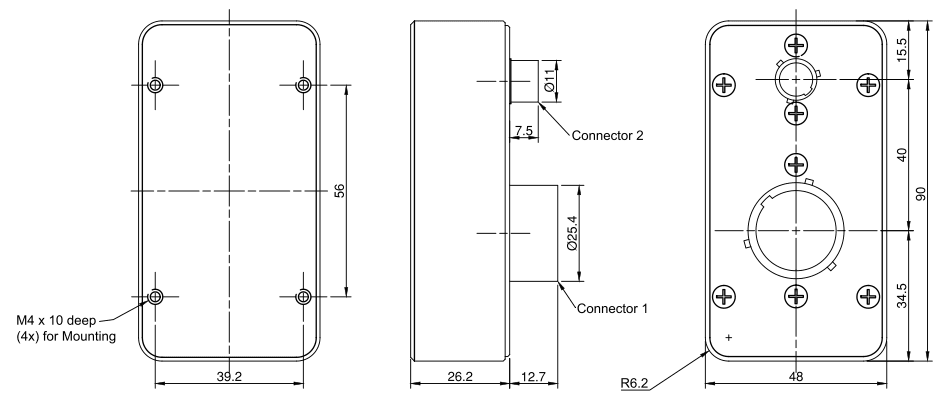
SVIM

VISIÓN GENERAL
The SVIM acquires data of the highest integrity for use in advanced chassis and suspension analysis. This versatile expander works in conjunction with Display Loggers C185, C187 or C1812 and Enclosed Logger L180 to facilitate the synchronised logging of high speed, high resolution inputs.
SVIMs are compact and can be located close to sensors, reducing the weight and complexity of wiring. When used in multiples, up to 200 sensor inputs are available.
CARATERISTICAS
- Samples 18 inputs at the same instant in time using 18 separate converters with 5th order anti-aliasing filters
- Supports many different types of sensors, including unamplified thermocouples and strain gauges
- Configured and controlled using Dash Manager software which has special programming functions for SVIM
- Multiple SVIMs are synchronised so every SVIM in the vehicle samples its high resolution AV inputs at the same instant in time – this is important when looking at the relationships of signals collected from different sensors around the vehicle and useful for test rigs and real time simulations
COMPATIBILIDAD
MoTeC Display Logger and Enclosed Logger Models
- 18047 – L180 – LOGGER
- 18068 – C185 – COLOUR DISPLAY LOGGER
- 18072 – C187 – COLOUR DISPLAY LOGGER
- 18053 – C1812 – COLOUR DISPLAY LOGGER (USB)
ESPECIFICACIONES
Inputs
- 6 x Fast analogue voltage inputs
- 10 x High resolution analogue voltage inputs
- 8 x High resolution differential analogue voltage inputs
- 2 x Speed inputs
Internal sensors
- Battery voltage
- Internal temperature
- Internal voltages
Communications
- 1 x CAN
Power supply
- Operating voltage 7 – 30 V
- Operating current 0.22 A excluding sensor currents
- Reverse battery protection
- Battery transient protection
Physical
- Case size 48 x 90 x 26.2 mm
- Weight 150 grams
- Ambient temperature range – 40 to 70 °C
Connectors
- 1 x 55 pin Autosport connector
- 1 x 5 pin Autosport connector
CABLEADO Y CONEXIONES
The SVIM is powered from the vehicle battery and connected to the Data Logger via the CAN bus.
Information on CAN bus wiring can be found in the Data Logger user manual, available for download from www.motec.com.au/downloads Please ensure wiring is according to CAN requirements and the CAN bus has at least one 100R terminating resistor.
The total available CAN bandwidth on a single CAN bus is 1 Mbit/sec. The bandwidth used by the total of all devices on the CAN bus must not exceed approximately 90% of this value (900000 bits/second)
If using multiple SVIMs and fast logging rates, it may be necessary to put some SVIMs on one CAN bus and some on the other to avoid exceeding the CAN bus bandwidth limit.
Approximate bandwidth = Total measurement rate (samples/second) x 30 (bits per sample)
The measurement rate for an input equals the logging rate or 50 Hz, whichever is higher.
The Dash Manager software will warn if the bandwidth is likely to be exceeded.
Example
- 4 channels at 2000 Hz
- 20 channels at 500 Hz
- 40 channels at 20 Hz (occupies 50 Hz)
Total measurement rate (samples/sec) = 4 x 2000 + 20 x 500 + 40 x 50 = 20000
Approximate bandwidth (bits/sec) = 20000 x 30 = 600000
| Battery voltage | ||||
|---|---|---|---|---|
| Sensor Supply Voltage | <15 V | 17 V | 20 V | 30 V |
| 5 V | 200 mA | 200 mA | 200 mA | 200 mA |
| 10 V | 200 mA | 150 mA | 100 mA | 50 mA |
SOFTWARE
- The SVIM has no stand-alone software package. It is configured using the Dash Manager software of the controlling Dash Logger.
- Open the Dash Manager software
- Select Connections > Devices
- To add an SVIM to the devices list, select Edit > Add
- Enter the SVIM serial number and name ad click OK
- Assign and calibrate the various inputs to a channel
CONECTORES Y PINOUT
Connector 1
55 pin Autosport connector
Mating connector: #68090
| Pin | Name | Function |
|---|---|---|
| 1 | 0V 1 | Sensor 0 V 1 |
| 2 | AV H1 | Analogue Volt High Res 1 |
| 3 | AV H2 | Analogue Volt High Res 2 |
| 4 | 0V 4 | Sensor 0 V 4 |
| 5 | 0V 1 | Sensor 0 V 1 |
| 6 | AV H3 | Analogue Volt High Res 3 |
| 7 | AV H4 | Analogue Volt High Res 4 |
| 8 | AV H5 | Analogue Volt High Res 5 |
| 9 | AV H6 | Analogue Volt High Res 6 |
| 10 | 0V 4 | Sensor 0 V 4 |
| 11 | R1 | Pull-up Resistor 1 |
| 12 | R2 | Pull-up Resistor 2 |
| 13 | AV H7 | Analogue Volt High Res 7 |
| 14 | AV H8 | Analogue Volt High Res 8 |
| 15 | AV D1+ | Analogue Volt Diff 1 + |
| 16 | AV D1- | Analogue Volt Diff 1 – |
| 17 | 0V 3 | Sensor 0 V 3 |
| 18 | 5V | Sensor 5 V |
| 19 | AV H9 | Analogue Volt High Res 9 |
| 20 | AV H10 | Analogue Volt High Res 10 |
| 21 | AV D8+ | Analogue Volt Diff High Res 8 + |
| 22 | AV D8- | Analogue Volt Diff High Res 8 – |
| 23 | AV D2+ | Analogue Volt Diff High Res 2 + |
| 24 | AV D2- | Analogue Volt Diff High Res 2 – |
| 25 | 0V 3 | Sensor 0 V 3 |
| 26 | 5V | Sensor 5 V |
| 27 | 5V | Sensor 5 V |
| 28 | AV D7+ | Analogue Volt Diff High Res 7 + |
| 29 | AV D7- | Analogue Volt Diff High Res 7 – |
| 30 | AV D5+ | Analogue Volt Differ High Res 5 + |
| 31 | AV D5- | Analogue Volt Diff High Res 5 – |
| 32 | 0V 2 | Sensor 0 V 2 |
| 33 | R3 | Pull-up Resistor 3 |
| 34 | R4 | Pull-up Resistor 4 |
| 35 | 5V | Sensor 5 V |
| 36 | AV D4+ | Analogue Volt Diff High Res 4 + |
| 37 | AV D4- | Analogue Volt Diff High Res 4 – |
| 38 | AV D6+ | Analogue Volt Diff High Res 6 + |
| 39 | AV D6- | Analogue Volt Diff High Res 6 – |
| 40 | 0V 2 | Sensor 0 V 2 |
| 41 | SPD1 | Speed 1 |
| 42 | SPD2 | Speed 2 |
| 43 | 5V | Sensor 5 V |
| 44 | 5V | Sensor 5 V |
| 45 | AV D3+ | Analogue Volt Diff High Res 3 + |
| 46 | AV D3- | Analogue Volt Diff High Res 3 – |
| 47 | AV F1 | Analogue Volt Fast 1 |
| 48 | AV F2 | Analogue Volt Fast 2 |
| 49 | AV F3 | Analogue Volt Fast 3 |
| 50 | AV F4 | Analogue Volt Fast 4 |
| 51 | AV F5 | Analogue Volt Fast 5 |
| 52 | AV F6 | Analogue Volt Fast 6 |
| 53 | 10V | Sensor 10 V |
| 54 | Not Used | |
| 55 | Not Used |
Connector 2
5 pin Autosport connector
Mating connector: #65033
| Pin | Name | Function |
|---|---|---|
| 1 | BAT – | Battery – |
| 2 | Not Used | |
| 3 | BAT + | Battery + |
| 4 | CAN LO | CAN Low |
| 5 | CAN HI | CAN High |
INFORMACION DEL PRODUCTO
Installation
IP Rating (dust or water ingress)
This product should be installed in a protected location where only occasional water splashing occurs and where the exposure to dust does not exceed conditions typical for vehicle installations.
Operating Temperature Range
This product is designed for an internal operating temperature range of -40 °C to 85 °C.
It should be installed in a location with sufficient air circulation and be shielded against thermal emissions from surrounding components.
Vibration Statement
This product is designed to withstand vibrations typical for normal vehicle installations.
It should not be exposed to severe and lasting vibrations. For example, the product should not be installed in solid connection to vibrating components like engines or undamped vehicle structures.
Safety
- For safe operation, use only undamaged.
- Minimal force should be exerted to plug in connectors.
- These devices may output voltages which may constitute a risk to human safety. Appropriate precautions must be taken:
- At no time operate the device with faulty, bare or exposed wiring.
- Adhere to the normal supply voltage limits as listed in the Basic Specifications section
- Adhere to wire gauges as listed in Wiring and Connecting.
Repair
Disposal

This product should be disposed of in accordance with relevant national regulations for disposal of electronic waste. It does not contain hazardous materials which might be subject to specific materials regulations.
